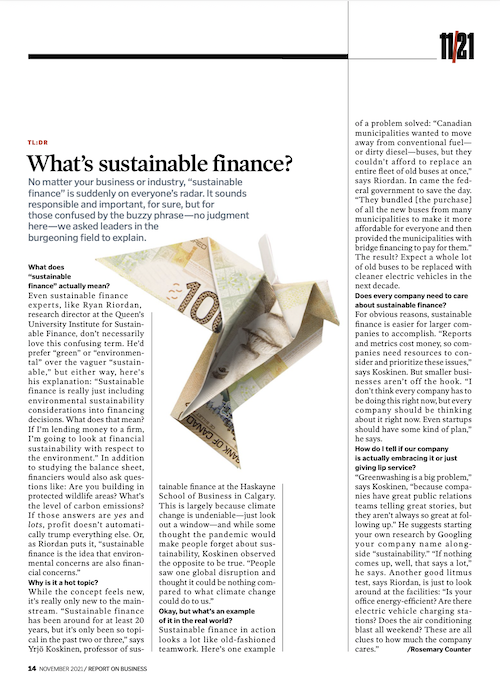What’s sustainable finance?
No matter our business or industry, “sustainable finance” is suddenly on everyone’s radar
It sounds responsible and important, for sure, but for those confused by the buzzy phrase–no judgment here–we asked leaders in the burgeoning field to explain.
What does “sustainable finance” actually mean?
Even sustainable finance experts, like Ryan Riordan, research director at the Queen’s University Institute for Sustainable Finance, don’t necessarily love this confusing term. He’d prefer “green” or “environmental” over the vaguer “sustainable,” but either way, here’s his explanation: “Sustainable finance is really just including environmental sustainability considerations into financing decisions. What does that mean? If I’m lending money to a firm, I’m going to look at financial sustainability with respect to the environment.” In addition to studying the balance sheet, financiers would also ask questions like: Are you building in protected wildlife areas? What’s the level of carbon emissions? If those answers are yes and lots, profit doesn’t automatically trump everything else. Or, as Riordan puts it, “sustainable finance is the idea that environmental concerns are also financial concerns.”
Why is it a hot topic?
While the concept feels new, it’s really only new to the mainstream. “Sustainable finance has been around for at least 20 years, but it’s only been so topical in the past two or three,” says Yrjö Koskinen, professor of sustainable finance at the Haskayne School of Business in Calgary. This is largely because climate change is undeniable—just look out a window—and while some thought the pandemic would make people forget about sustainability, Koskinen observed the opposite to be true. “People saw one global disruption and thought it could be nothing compared to what climate change could do to us.”
Okay, but what’s an example of it in the real world?
Sustainable finance in action looks a lot like old-fashioned teamwork. Here’s one example of a problem solved: “Canadian municipalities wanted to move away from conventional fuel—or dirty diesel—buses, but they couldn’t afford to replace an entire fleet of old buses at once,” says Riordan. In came the federal government to save the day. “They bundled [the purchase] of all the new buses from many municipalities to make it more affordable for everyone and then provided the municipalities with bridge financing to pay for them.” The result? Expect a whole lot of old buses to be replaced with cleaner electric vehicles in the next decade.
Does every company need to care about sustainable finance?
For obvious reasons, sustainable finance is easier for larger companies to accomplish. “Reports and metrics cost money, so companies need resources to consider and prioritize these issues,” says Koskinen. But smaller businesses aren’t off the hook. “I don’t think every company has to be doing this right now, but every company should be thinking about it right now. Even startups should have some kind of plan,” he says.
How do I tell if our company is actually embracing it or just giving lip service?
“Greenwashing is a big problem,” says Koskinen, “because companies have great public relations teams telling great stories, but they aren’t always so great at following up.” He suggests starting your own research by Googling your company name alongside “sustainability.” “If nothing comes up, well, that says a lot,” he says. Another good litmus test, says Riordan, is just to look around at the facilities: “Is your office energy-efficient? Are there electric vehicle charging stations? Does the air conditioning blast all weekend? These are all clues to how much the company cares.”
